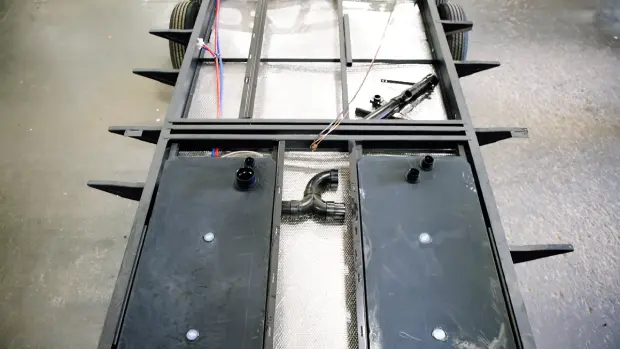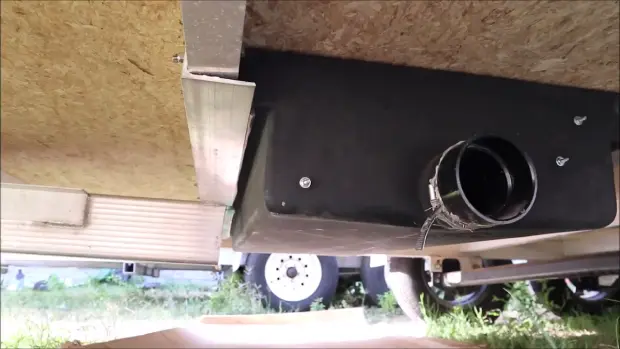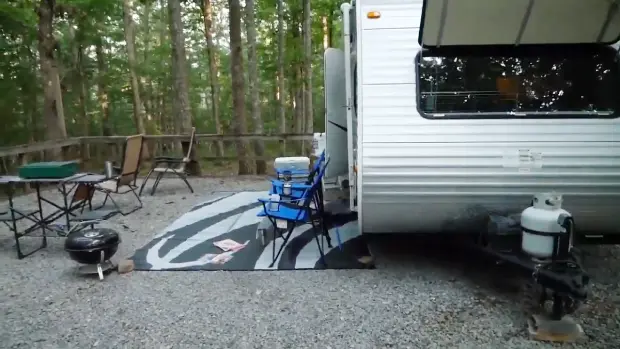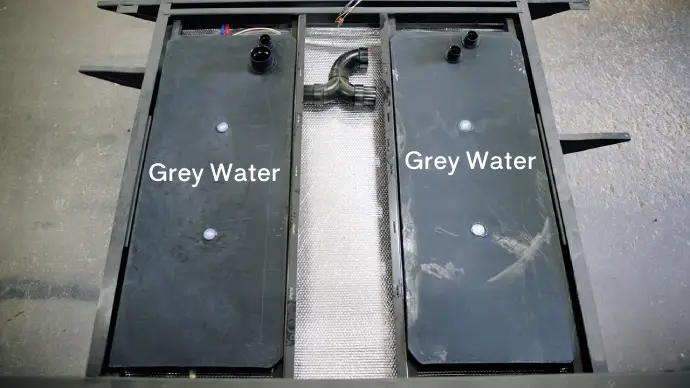Last Updated on May 25, 2023
Whether new to the RV lifestyle or a seasoned veteran, having two grey water tanks may seem unnecessary. But there are plenty of reasons why your home away from home is equipped with this feature and those answers might just surprise you.
From space and weight distribution to convenience, practicality, and even legal requirements and environmental regulations, these tanks ensure that your RV operates smoothly and efficiently. Understanding what each tank is used for and how they work will help you get the most out of your RV experience.
So whether you’re a seasoned RV owner or just starting out, understanding the purpose of these tanks is key.
Why Does My RV Have Two Grey Water Tanks: Top 4 Reasons

Dual grey water tanks in an RV might seem like an unnecessary luxury, but there are actually several reasons why some RVs have this feature. Let’s take a closer look at each of them:
ONE: Space and Weight Distribution
Grey water is wastewater that comes from sinks, showers, and washing machines, among other sources. It’s important to properly dispose of this water to prevent environmental damage or legal issues.
Having two grey water tanks can help distribute the weight of the wastewater more evenly throughout the RV, making it easier and safer to tow or drive.
Having two grey water tanks can also provide more space for freshwater storage or black water (sewage) storage. This is especially important for RVers who plan on dry camping or boondocking, where access to utilities may be limited.
TWO: Convenience and Practicality
Having two grey water tanks in an RV can provide the owner a lot of convenience and practicality. Two tanks can be used exclusively for the kitchen sink and dishwasher, while the other is used for the bathroom sink, shower, and washing machine.
This separation helps prevent any food particles or grease from clogging up the pipes or causing unpleasant odors.
Additionally, having two tanks means that if one becomes full, another tank is still available for use. This can be especially helpful when camping in areas where dumping stations are not readily available.
THREE: Legal Requirements and Environmental Regulations
RVers are turning to two-tank systems, giving them the freedom and flexibility to stay in line with legal requirements and environmental regulations. Not only does this make for stress-free camping trips, but it also provides peace of mind that resources are being conserved responsibly.
Many states and national parks have strict regulations on wastewater disposal, which means that RVers must follow specific guidelines to avoid hefty fines. Having two grey water tanks allows RVers to comply with these regulations by separating the grey water from the black water, which contains human waste.
In some places, dumping black water into the environment is illegal or requires a special permit. Having two separate tanks allows RVers to easily dispose of their wastewater without breaking any laws.
Moreover, having two grey water tanks also helps comply with environmental regulations. Greywater is less harmful than blackwater but still contains soap residue and food particles that can harm the environment if not disposed of properly.
By separating the greywater from blackwater, RVers can ensure that they are disposing of wastewater in an environmentally friendly way.
In addition to legal requirements and environmental regulations, some campgrounds require RVs to have two greywater tanks for practical reasons. Some campgrounds only allow gray water discharge in designated areas or require a certain type of sewer connection.
Having two separate tanks makes it easier for RVers to comply with these rules and regulations.
FOUR: Customization and Personal Preference
For those who love the open road and adventure that comes with it, having the perfect RV is essential. For some, this means having two grey water tanks as standard features right from the manufacturer, while for others, it means customizing their RV as per their specific needs and preferences.
The beauty of customization is that you get to tailor your RV to meet your specific needs, whether that be increased freshwater storage, adherence to legal requirements or environmental regulations, or simply a practical and convenient wastewater disposal system.
With two grey water tanks, RVers have the flexibility they need to have an optimal RV experience.
What Are Types Of RVs With Two Grey Water Tanks?

RVers who want the convenience and practicality of two grey water tanks can find a variety of vehicles to choose from. Whether you’re an experienced RVer or just starting out, there is an RV for everyone. Here are some of the most popular types:
#1. Fifth-Wheel Trailers
Fifth-wheel trailers are a popular type of RV that often come equipped with two grey water tanks. These tanks are typically located underneath the trailer and collect wastewater from the sinks, shower, and washing machine.
Fifth-wheel trailers have two grey water tanks because of space and weight distribution. Fifth wheels are designed to be towed by a pickup truck, with the hitch located in the truck’s bed.
#2. Motorhomes
Motorhomes are also an increasingly popular choice for RV enthusiasts looking to hit the open road in style. These sleek and spacious vehicles offer a comfortable and convenient way to travel, with all the modern amenities you could need.
One of the most important features of any motorhome is the grey water tanks. These are specially designed to hold all the wastewater from the sinks, showers, and appliances onboard. This practical choice helps distribute weight evenly and optimizes fuel economy and performance.
#3. Travel Trailers with Front Kitchens
Grey water tanks are often found in travel trailers with front kitchens. This is because the kitchen is typically located at the front of the trailer, far from the bathroom where the other grey water tank is usually located.
Having two separate greywater tanks allows for a more efficient wastewater disposal system. The kitchen tank can be emptied first before the bathroom tank needs to be emptied, saving time and energy when emptying out the tanks.
How to Maintain an RV With Two Grey Water Tanks?
Maintaining your RV’s two grey water tanks is crucial to ensure a smooth and hassle-free camping experience. Keep these tips in mind for maintenance:
One: Regular Cleaning and Flushing
To keep your RV in top shape, it’s important to take some simple preventive measures – like regular grey water tank cleanings. Depending on usage and occupancy rates, the frequency of these flushings can vary from voyage to voyage, or you could opt for a monthly rhythm instead.
Here’s how to clean your grey water tanks:
- Empty the tank: Before cleaning the tank, ensure it’s empty. You can do this by draining the grey water into a sewer dump station or using a portable waste tank.
- Add cleaning solution: Various types of cleaning solutions are available in the market specifically designed for RV grey water tanks. These solutions help break down waste and eliminate odors. Follow the instructions on the product label to determine how much solution to add to your tank.
- Fill the tank with water: After adding the cleaning solution, fill your grey tank with fresh water until it’s about 2/3 full.
- Let it sit: Once you’ve filled up the tank with freshwater and cleaning solution, let it sit for several hours or overnight, depending on what is suggested on the product label.
- Drain and rinse: After letting everything sit for an appropriate amount of time, drain out all of the contents from your greywater tanks into a sewer dump station or portable waste tank before rinsing it thoroughly with fresh water.
Two: Monitoring Tank Levels and Usage
Proper monitoring of greywater tank levels is necessary to avoid troublesome and costly RV plumbing issues. With these useful tips, you’ll be able to keep track of your tanks and use them efficiently easily:
- Install a Tank Monitoring System: This system will help you keep track of your tank levels without manually checking them. Different types of monitoring systems are available in the market that use sensors to measure the level of liquid in the tanks.
- Check Tank Levels Regularly: It’s essential to check your tank levels regularly, especially before and after a trip. This helps you determine how much space is left in each tank and when it’s time to empty them.
- Use Tank Level Indicator: Some RVs come with built-in tank level indicators that show how full each tank is. If your RV doesn’t have this feature, you can purchase an aftermarket indicator that attaches to the outside of the tanks.
- Keep Track of Water Usage: You should also monitor your water usage while using the RV’s kitchen sink, bathroom sink, shower, or toilet. Keeping track of water usage will give you an idea of how quickly the tanks fill up.
- Empty Tanks Regularly: Both grey water tanks need to be emptied regularly to prevent overflows and leaks. The frequency depends on how often you use your RV and how many people travel with you.
Do You Prefer to Open Or Close Your Grey Water Tanks?

As a professional, it is important to consider your actions’ impact on the environment and those around you. Although leaving your gray valve open seems convenient to avoid constantly dumping your gray tank, it can also emit unpleasant sewer smells.
Furthermore, allowing water to constantly run down the drain without monitoring the tank’s level is wasteful and harmful to natural resources. Keeping an eye on your gray water tank level and dumping it in a proper disposal area will prevent any negative effects that may occur.
Taking this approach not only promotes responsible behavior but also reflects your professional image well.
Does the Grey Water Tanks Only Hold Water From the Shower?
Grey water tanks hold water from various sources besides just the shower. While a significant portion of the grey water does come from showering, it also includes water used for washing hands, laundering clothes, cleaning dishes, and other household activities. That’s why people prefer two grey tanks.
Using greywater tanks is a sustainable practice that can save significant water by recycling it for non-potable purposes. Additionally, using grey water can reduce the amount of wastewater generated and ultimately treated, thereby decreasing the environmental impact.
RVing with Grey Water Tanks: Get Ready for the Adventure
For any ardent traveler, two greywater tanks can prove to be immensely advantageous. The benefits are numerous, such as improving the efficiency of water usage and extending the time between tank dumps, among many others.
Also, it allows for a sense of ease and comfort during long journeys, reducing the need for multiple stops just to empty the grey water tanks. Even so, proper management and maintenance of these tanks are crucial to their longevity and functionality.
Understanding the purpose and advantages of having multiple greywater tanks in an RV is essential to make the most of the traveling experience. With this knowledge, set out in your RV and enjoy the journey without any worries.



